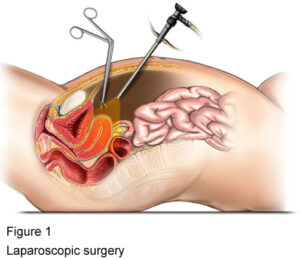
Gyneco laparoscopy is a minimally-invasive surgical procedure that helps your surgeon to see inside your lower abdomen with the help of a camera called laparoscope. Because of the minimally-invasive nature of this surgery, it is also referred to as “keyhole surgery”. Internal organs such as ovaries, womb and fallopian tubes can be visualized this way. Other parts of the body such as bowel and bladder can also be examined this way. Apart from examining the internal organs around the tummy, through some specially-made instruments, the surgeon can conduct some tests or can treat some gynecological conditions.
Laparoscopy can be used for gynecological purposes to find out and treat the following symptoms and conditions:
- diagnosing and treating endometriosis
- removing adhesions – there can be development of scars after infections such as pelvic inflammatory disease or due to endometriosis
- treating an ectopic pregnancy – when pregnancy happens outside your womb
- sterilization, which means closing your fallopian tubes to avoid getting pregnant
- removal of an ovarian cyst
- removal of your womb (hysterectomy) or ovaries (oophorectomy)
- removal of fibroids (myomectomy)
- investigating if there is presence of cancer or if it has spread to nearby areas
During the laparoscopic procedure, your surgeon might take a small tissue as a sample for biopsy. This is then sent to a laboratory to see what type of cells is in it – benign (not cancerous) or malignant (cancerous). A biopsy can also throw light on the presence of endometriosis.
Am I a candidate for gyneco laparoscopy?
Think about the severity of the gynecological issues faced by you and if you think they warrant a specialist opinion, seek the service of your gynecological surgeon. The decision to go in for a gyneco laparoscopy is based on the symptoms you explained and the surgeon’s decision post physical examination. Let’s go through some of the advantages of a gyneco laparoscopy.
- the cause of your symptoms and the cause of your infertility can be found out
- your condition can also be treated at the time of its diagnosis
- compared to an open surgery such as laparotomy, time taken for recovery is quick
- chances of complications are minimal
Preparation for the procedure:
After zeroing in on the procedure, your surgeon will explain how to prepare for the procedure. In the unlikely event, if you have the habit of smoking, you may be asked to stop it as it would increase the risk of getting a chest and wound infection which can hamper your recovery process. If the procedure is done to diagnose a condition, more often than not you can go home the very same day. However, if it is done to treat a condition, you may be required to stay in hospital overnight. As a basic step before any operation, it is important not to eat anything six hours before your operation. You can drink up to two hours before the surgery. Once you have reached the hospital for the procedure, your heart rate and blood pressure will be checked. Your urine will also be checked to make sure that you are not pregnant. In order to prevent blood clots forming in your veins in your legs, you may be asked to wear compression stockings. Apart from that, an injection of an anti-clotting medicine may also be administered.
Your surgeon will explain in detail as to what will happen during the procedure. If you need clarity on anything, feel free to ask as no question is small. Being fully informed will put you at ease.
Procedure:
After proper anesthesia is given, a laparoscope (almost similar to a hysteroscope) is inserted to pelvic and abdominal cavities through the small incisions made in your abdomen. A medical tube is inserted into one of the cuts and here, as opposed to fluid, carbon dioxide gas is used to expand the cavity for proper visualization of the internal organs. If there is the need to take a tissue sample or correct a condition, some other medical devices will also be inserted through the cuts made. Once the procedure is over, the surgeon will take out the instruments out of your abdomen gently and carefully and the incisions made will be closed with stitches or glue.
Post procedure:
You have to take rest till the effect of the anesthesia wears off. When the effect of the anesthesia subsides, you may feel a little discomfort. You may be given painkillers to deal with the pain thus arising. You may spot some bleeding in the vagina post procedure, which is common. However, if it is heavy and there is presence of passing clots, you should present to the hospital for medical examination and advice. Make sure somebody is there to drive you back home post procedure.
To conclude, many medical conditions that previously required traditional surgery can now be done through laparoscopically as the chances of complications are less and the time taken for recovery is minimal.
For enquiries related to Gynaec related Laparoscopy Surgery, send a message to www.KJKHospital.com/contact





